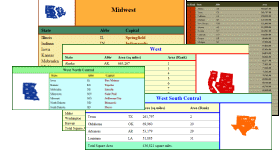
|

|

|
Xport: US Statistical Report Suite Overview
This report suite demonstrates many of the features of Xport, and shows various types of reports that can be generated. There are many different reports created by the report suite, which allows you to see multiple methods to achieve the same result. By studying the source code used to generate the various reports, you'll get a good understanding of the various ways you can use Xport to generate your own reports.
The report suite includes a class hierarchy for generating the various reports. The statistical state data used in the reports is retrieved from a text file named states.txt. Each report is generated by a derived report generating class . These classes are all derived from a base report generating class, us_state_report_generator. This base class includes some common data retrieval methods used by all the derived report generating classes. The reports are created inside main().
The report suite is wrapped in a namespace, Xport_report_suite. There are no project or workspace files included in the suite, since the suite is not compiler specific. To compile the suite, you'll need to create a project to include all the report suite source code files. Since the suite uses Xport, you'll need to include the Xport source code files in the same project, or better, create a seperate project for Xport, which can then be included in the report suite project. This method is preferrable, as it will keep the report suite source code files seperate from Xport's source code files.
The US Statistical Report Suite consists of the following source code files.
-
us_report_generator.h/cpp
Base report class for all reports. -
State Capital Report classes
- state_capital_report_generator.h/cpp
- divisional_state_capital_report_generator.h/cpp
- regional_state_capital_report_generator.h/cpp
-
Square Area Report classes
- state_area_report_generator.h/cpp
- divisional_area_report_generator.h/cpp
- regional_area_report_generator.h/cpp
-
Density Report classes
- density_report_generator.h/cpp
- divisional_density_report_generator.h/cpp
- regional_density_report_generator.h/cpp
Many more reports will be added to the report suite in the comming months, so check back periodically to this page.
The full test suite can be downloaded at the report suite download page. You'll also need to download Xport, if you haven't already.
